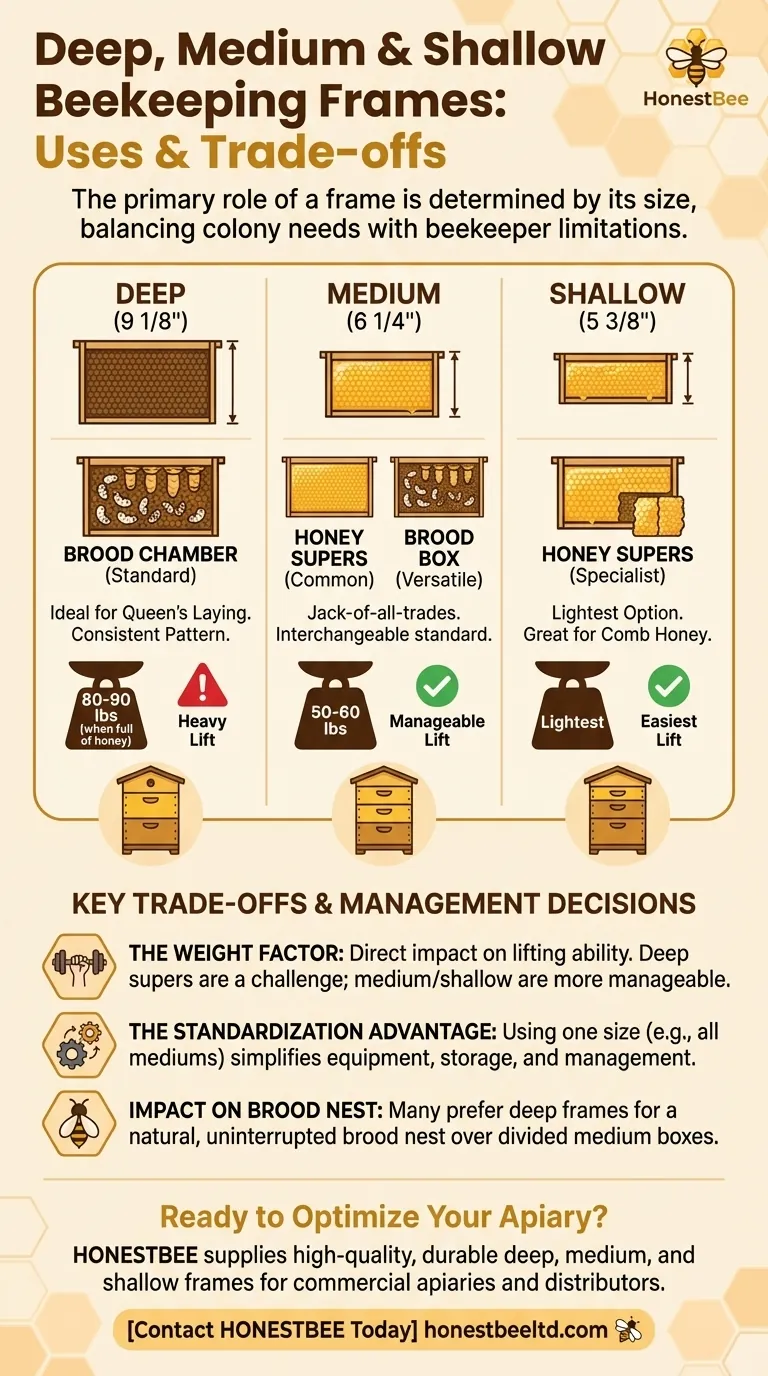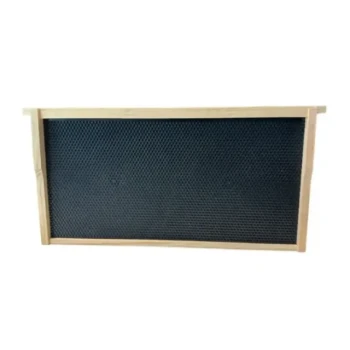The primary role of a beekeeping frame is determined by its size. Deep frames are the standard for the brood chamber where the queen lays eggs. Medium frames are a versatile option often used for lighter honey supers but can also serve as brood boxes. Shallow frames are used almost exclusively as the lightest option for honey supers.
The choice between deep, medium, and shallow frames is a fundamental decision in beekeeping that balances the needs of the bee colony against the physical limitations and management preferences of the beekeeper.

The Purpose of a Frame in the Hive
Supporting the Colony's Foundation
A frame's basic function is to provide a structure that holds the honeycomb. Bees use this wax comb for two critical purposes: raising their young (brood) and storing food (honey and pollen).
Frames bring order to the hive, allowing the beekeeper to inspect the colony's health, manage its growth, and harvest honey without destroying the comb structure.
Decoding Frame Sizes and Their Primary Roles
The three standard frame heights correspond to the hive boxes they fit inside: deep, medium, and shallow. Each is tailored for a specific purpose within the hive.
Deep Frames: The Standard for the Brood Chamber
Deep frames (9 1/8 inches) are the most common choice for the main living quarters of the hive, known as the brood box or brood chamber.
This large, uninterrupted surface area is ideal for the queen. It allows her to lay eggs in a consistent, solid pattern, which is crucial for raising a healthy and populous colony. While they can be used for honey, a deep frame full of honey can weigh 80-90 pounds, making it impractical for many beekeepers to lift.
Medium Frames: The Versatile Workhorse
Medium frames (6 1/4 inches) are the jack-of-all-trades in beekeeping. Their most frequent use is for honey supers—the boxes stacked on top of the brood chamber for honey storage.
A full medium frame of honey weighs a more manageable 50-60 pounds. Some beekeepers also opt to use medium frames for their brood boxes, creating a standardized hive where every frame and box is interchangeable. This simplifies equipment management, though it requires two medium boxes to approximate the brood space of one deep box.
Shallow Frames: The Specialist for Light Honey Supers
Shallow frames (5 3/8 inches) are the least common but serve a specialized role. They are used exclusively for honey supers.
Their key advantage is weight; a full shallow frame is the lightest option, making it ideal for beekeepers with lifting limitations. They are also favored for producing comb honey, where the entire honeycomb is harvested and sold intact. Due to their small size, they are not considered suitable for brood chambers as they would fragment the queen's laying pattern.
Understanding the Key Trade-offs
Choosing a frame size isn't just about technical specifications; it's about practical management decisions that affect your beekeeping experience.
The Weight Factor
The most significant trade-off is weight. Your ability to lift heavy boxes directly influences your choice, especially for honey supers. A deep super is a significant physical challenge, while medium and shallow supers offer much more manageable alternatives.
The Standardization Advantage
Using a single frame size for the entire hive, typically all mediums, simplifies your operation. You never have to worry about putting the wrong size frame in the wrong box. All your equipment is interchangeable, making hive manipulations and equipment storage much easier.
The Impact on the Brood Nest
While standardization is convenient, many beekeepers prefer a deep brood chamber. They argue that the single, large frame is more natural for the queen and promotes a stronger brood nest compared to the divided space created by two stacked medium boxes.
Making the Right Choice for Your Apiary
Your decision should align with your physical abilities and management goals.
- If your primary focus is a traditional setup with maximum brood space: Use deep frames for your brood boxes and medium or shallow frames for your honey supers.
- If your primary focus is simplifying equipment and keeping lifts manageable: Use medium frames for both your brood boxes and your honey supers.
- If your primary focus is having the lightest possible honey boxes: Use deep or medium brood boxes but exclusively use shallow frames for your honey supers.
Ultimately, the best frame configuration empowers you to manage your hives confidently and effectively.
Summary Table:
| Frame Type | Primary Use | Key Characteristic |
|---|---|---|
| Deep (9 1/8") | Brood Chamber | Ideal for queen's egg-laying; heavy when full of honey (80-90 lbs). |
| Medium (6 1/4") | Versatile Workhorse | Common for honey supers (50-60 lbs); can be used for brood in a standardized hive. |
| Shallow (5 3/8") | Honey Supers | Lightest option; ideal for beekeepers with lifting limitations or for comb honey production. |
Ready to build or standardize your apiary with the right frames?
HONESTBEE supplies high-quality beekeeping supplies and equipment to commercial apiaries and beekeeping equipment distributors through our wholesale-focused operations. We can provide the durable deep, medium, and shallow frames you need to optimize your hive management.
Contact HONESTBEE today to discuss your equipment needs and streamline your beekeeping operation.
Visual Guide

Related Products
- Plastic Bee Frame Beekeeping Hive Frames for Wholesale
- Assembled Wooden Bee Frames with Beeswax Foundation Ready to Use by HONESTBEE
- 3.5L Plastic Beehive Frame Feeder Deep Frame Water Feeder for In Hive Use
- HONESTBEE Wired and Assembled Wooden Bee Frames Foundation for a Thriving Hive
- Assembled Wooden Bee Frames with Plastic Foundation for Durability and Convenience by HONESTBEE
People Also Ask
- Why are plastic frames popular in commercial beekeeping? Boost Efficiency & Durability at Scale
- Are plastic bee hive frames good? A Guide to Modern Durability vs. Natural Appeal
- What are the advantages of plastic frames for beehives? Boost Apiary Efficiency & Durability
- Can you boil plastic bee frames? Avoid This Costly Mistake and Protect Your Hive
- What is a general rule for beekeepers with many hives regarding frame choice? Maximize Efficiency with Plastic Frames



















